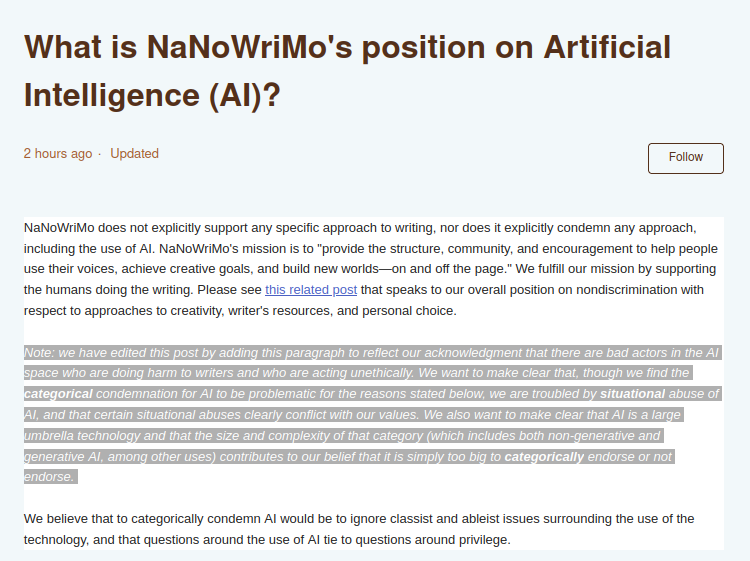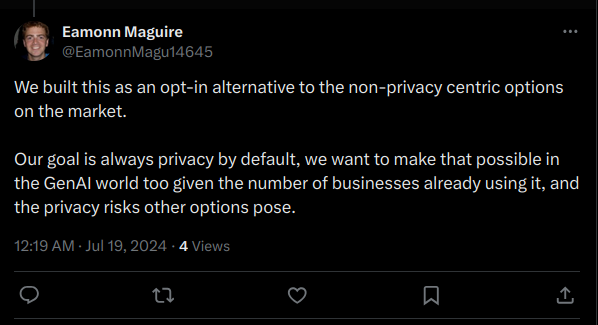They’re gonna start announcing real concrete nefarious-ass use cases real soon
It’s so frustrating to see how egregious the future tense has become in all the talking about these products. Also the anticipation of a killer app is never going to sound not desperate.
fyi they updated their blog post with this catch-all disclaimer in the last couple of hours

"it is simply too big to categorically endorse or not endorse"
"so we're gonna play it safe and endorse it"
I joined a writing meetup here in Amsterdam which gathers every week in a bar to write, to talk about their writing, to bounce ideas, etc. I kinda got tired of going because there were a worrying number of people using chatgpt to generate ideas. I was the only one trying to write non-fiction, and most of what I was writing would be crit of tech (sometimes genAI) so talking about my writing was always fun. But nonetheless, their use of chatgpt seemed extra weird because we were there, together, to write and support each other, for free.
It's strange to use solidarity, support, and just general helpfulness from others as an explanation for how AI opens writing up to classes or abilities when that's probably one of the top things that social media (and pre-social media social media) gave us on the internet.
anyway..
"it is providing Microsoft non-exclusive access to advanced learning content and data to help improve relevance and performance of AI systems".
I wish it wasn't normal to call these "systems" instead of "products"
the usefulness of any feature should be measured in how deep you can bury its "opt-in" option in the settings pages without hurting its adoption
Eamonn Maguire, author of the Proton Scribe announcement post, responded to my tweet with this: https://x.com/EamonnMagu14645/status/1814062340863651965
We built this as an opt-in alternative to the non-privacy centric options on the market.
Our goal is always privacy by default, we want to make that possible in the GenAI world too given the number of businesses already using it, and the privacy risks other options pose.

Is it absurd that the maker of a tech product controls it by writing it a list of plain language guidelines? or am I out of touch?
i like how he sees the "consent problem" as just a communication thing. "if they could speak, they would be saying yes"
"learn AI now" is interesting in how much it is like the crypto "build it on chain" and how they are both different from something like "learn how to make a website".
Learning AI and Building on chain start with deciding which product you're going to base your learning/building on and which products you're going to learn to achieve that. Something that has no stability and never will. It's like saying "learn how to paint" because in the future everyone will be painting. It doesn't matter if you choose painting pictures on a canvas or painting walls in houses or painting cars, that's a choice left up to you.
"Learn how to make a website" can only be done on the web and, in the olden days, only with HTML.
"Learn AI now", just like "build it on chain" is nothing but PR to make products seem like legitimised technologies.
Fuckaduck, ai is the ultimate repulseware
When I worked in agencies you could pick the suits that had lost touch with reality by how much they seemed to believe that targeted ads are useful enough to be some kind of public service. Now google use the same rhetoric to justify user tracking

Maybe I’m scarred but I have a reflexive distrust for any usage of “pumped” or “super excited” in a commercial context. No matter the subject.